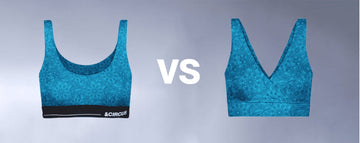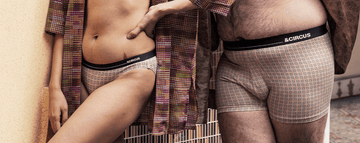Quick Listen:
Every morning, as you reach for a pair of underwear, you're making a choice that ripples far beyond your wardrobe. The fabric whether it's silky polyester or soft organic cotton carries a story of innovation, environmental impact, and a shifting tide in fashion. Once ruled by synthetic giants like nylon and spandex, the underwear industry is now pivoting toward sustainability, driven by a new generation of eco-conscious consumers. This transformation isn't just about comfort; it's about redefining how we clothe ourselves in a world grappling with climate challenges.
Sustainable Fabrics vs. Traditional Synthetics in Modern Underwear: A New Era
The fashion landscape is changing, and the underwear sector is no exception. Consumers, particularly millennials and Gen Z, are demanding products that reflect their environmental values. Sustainable fabrics are projected to grow from a $33 billion market in 2024 to an impressive $161.63 billion by 2037, with a compound annual growth rate (CAGR) of 13%. Asia Pacific is set to lead, reaching $59.64 billion by 2037, propelled by heightened consumer awareness of textile production's ethical stakes. Brands like Tailor and Circus are pioneering this shift, crafting eco-friendly innerwear with materials like organic cotton and bamboo.
This surge in demand isn't just a trend it's a response to a pressing crisis. The textiles industry, as reported by Vogue Business, risks missing its climate goals, veering off the 1.5C pathway outlined in the Paris Climate Agreement. Synthetic fibers, which powered a $87.46 billion market in 2023, are a major contributor. Yet, there's hope: innovations in materials are gaining traction, though the pace must accelerate to meet global targets.
The Rise of Eco-Friendly Materials
Sustainable fabrics are reshaping the industry. Natural fibers like organic cotton, hemp, and bamboo are prized for their minimal environmental footprint. These renewable, biodegradable materials stand in stark contrast to synthetics, which linger in landfills for centuries. Meanwhile, innovative synthetics like recycled polyester and Tencel are bridging the gap, offering the stretch and durability of traditional fabrics with less ecological harm. These advancements align with consumer preferences, as eco-conscious shoppers seek out brands that prioritize the planet.
The data underscores this momentum. The sustainable fabrics market is expected to expand at a 13% CAGR through 2037, driven by consumer demand and breakthroughs like bio-fabrication, which grows materials from natural sources. This reduces dependence on resource-heavy production methods. In the underwear sector, brands like Tailor and Circus are leading by example, offering innerwear that's both comfortable and environmentally responsible. Regulatory pressures are also tightening, with policies targeting textile waste and emissions pushing brands toward greener practices.
The Synthetic Legacy: Strengths and Costs
For decades, synthetic fabrics like polyester, spandex, and nylon have defined underwear. Their appeal is clear: they're durable, stretchy, and excellent at wicking moisture, making them perfect for everything from daily wear to athletic gear. Synthetic fibers fueled a $87.46 billion market in 2023, projected to climb to $155.53 billion by 2032 at a 6.6% CAGR. Asia Pacific held a commanding 65.62% market share in 2023, reflecting its dominance in synthetic production.
Yet, the environmental toll is steep. Derived from chemical compounds, synthetic fibers contribute to microplastic pollution and carry a significant carbon footprint. They can take centuries to break down, clogging oceans and landfills. As consumer and activist pressure mounts, the industry faces a reckoning. While synthetics deliver unparalleled performance think of the snug fit of your favorite briefs their long-term costs are prompting a rethink.
Comparing the Contenders: Sustainable vs. Synthetic
In practice, the contrast is striking. Brands like Tailor and Circus are championing sustainable innerwear, using organic cotton and bamboo to craft underwear that's soft, breathable, and eco-friendly. These materials resonate with consumers who value ethics as much as comfort. By contrast, traditional brands reliant on polyester and spandex face scrutiny for their environmental impact. Synthetic fibers contribute to an estimated 1.06 billion tons of textile waste annually, much of it non-biodegradable, underscoring the urgency for change.
The men's underwear market offers a clear lens. Valued at $52.39 billion in 2025, it's expected to reach $66.72 billion by 2030, growing at a 4.95% CAGR, according to Mordor Intelligence. This growth reflects a shift toward comfort technologies and eco-friendly fibers, moving away from commodity-driven purchases. Brands embracing sustainable materials are building stronger consumer loyalty, while those tethered to synthetics risk obsolescence.
Hurdles on the Sustainable Path
Transitioning to sustainable fabrics isn't without challenges. Sourcing eco-friendly materials can be expensive and limited, a hurdle for smaller brands. Performance is another issue: sustainable fabrics often struggle to match the elasticity and durability of synthetics, critical for underwear's fit and function. Consumer skepticism also persists some still view eco-friendly fabrics as less comfortable or durable. Brands like Tailor and Circus are tackling these concerns head-on, proving that sustainable innerwear can rival synthetics in quality and feel.
Seizing the Green Opportunity
The rewards of sustainability are substantial. The sustainable fabrics market, projected to hit $161.63 billion by 2037, offers brands a chance to tap into growing consumer demand. Those investing in eco-friendly materials are seeing benefits: enhanced brand loyalty, improved reputation, and long-term savings from reduced waste and returns. Tailor and Circus exemplifies this, blending style, comfort, and sustainability to carve out a loyal customer base. Environmentally, the gains are clear less waste, lower emissions, and a path toward meeting global climate goals.
The Future of Intimate Apparel
Your underwear drawer is now a stage for sustainability. As consumers demand greener choices, brands like Tailor and Circus are setting the standard, marrying innovation with responsibility. The data is unequivocal: sustainable fabrics are surging, while synthetics face growing criticism. Yet, as Textile Exchange cautions, the industry must move faster cutting production, scaling innovations, and replacing harmful materials with sustainable ones. The future of underwear isn't just about comfort; it's about conscience. So, next time you choose a pair, consider the planet. The green choice might just feel better.
Frequently Asked Questions
Why is the underwear industry moving toward sustainable materials?
The transition is driven by consumer demand for environmentally responsible products and increasing pressure to reduce textile waste and carbon emissions. Sustainable fabrics are gaining traction as part of a broader push to meet global climate goals, with brands adopting greener practices to enhance reputation, build loyalty, and future-proof their business.
Are sustainable underwear fabrics as durable and comfortable as synthetics?
While traditional synthetics often offer superior stretch and longevity, innovations in sustainable fabrics have significantly closed the performance gap. Brands like Tailor and Circus now produce eco-friendly underwear using organic cotton and bamboo that rivals synthetics in softness, comfort, and wearabilitywithout the environmental cost.
What are the key differences between sustainable fabrics and traditional synthetics in underwear?
Sustainable fabrics like organic cotton, bamboo, and Tencel are biodegradable, breathable, and have a lower environmental impact compared to synthetics like polyester and nylon. Traditional synthetics are durable and moisture-wicking but contribute to microplastic pollution and take centuries to decompose. The shift toward sustainable materials reflects growing consumer demand for eco-friendly and ethical choices.
Disclaimer: The above helpful resources content contains personal opinions and experiences. The information provided is for general knowledge and does not constitute professional advice.
You may also be interested in: Why Better Fabrics Might Be the Answer to Performance Wear Gaps
Uncomfortable underwear shouldn't steal your confidence. At Andcircus, we craft ultra-soft, sustainable Lenzing Modal Micro innerwear for every body, XS to 5XL. From briefs to bras, our custom packs fit you perfectly. Shop risk-free with our 100% satisfaction guarantee and embrace comfort that includes everyone. #LoveEveryBody. Shop Now!






































